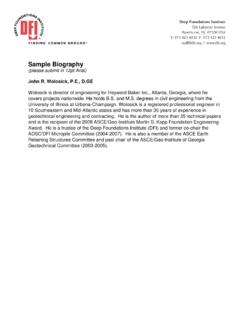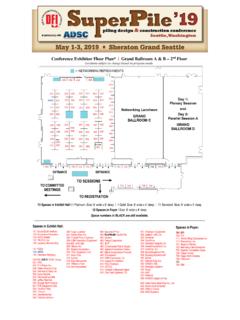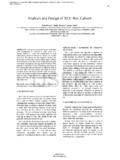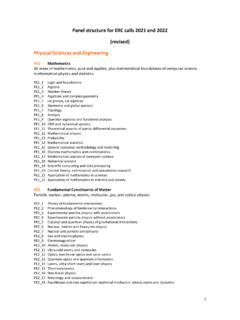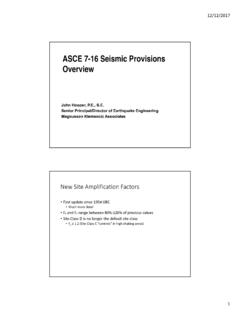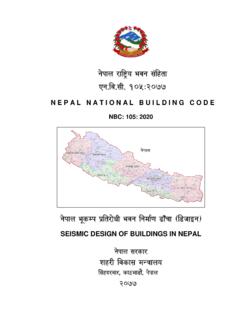Transcription of OMPARISON OF IMPAT VERSUS VIRATORY DRIVEN PILES: …
1 COMPARISON OF IMPACT VERSUS VIBRATORY DRIVEN PILES: With a focus on soil - structure interaction oc Number Report Title Revision Date Authored Checked 14007-01 Comparison of impact VERSUS vibratory DRIVEN piles REV0 28/11/2014 IR PD 14007-01 Comparison of impact VERSUS vibratory DRIVEN piles REV1 06/07/2015 IR PD 14007-01 Comparison of impact VERSUS vibratory DRIVEN piles REV2 07/09/2015 IR PD 1 14007-01-Rev2 COMPARISON OF IMPACT VS. VIBRATORY DRIVEN PILES Table of Contents Executive Summary .. 3 Acknowledgements .. 4 1 Introduction .. 5 2 Literature Review .. 6 6 What to consider? .. 7 Vibro- DRIVEN piles in recent projects.
2 9 Vibratory Systems .. 13 Parameters of vibratory systems .. 17 3 soil - structure Interaction .. 20 Pile- soil Installation Effects during Impact Driving .. 20 Effects in soil of Vibratory Driving .. 21 Pore pressure generation and liquefaction .. 22 Cyclic stress-strain behaviour .. 22 Cyclic damping .. 25 Strain rate dependency .. 26 Vibrations and acceleration .. 27 Plugging differences between vibratory and impact piles .. 29 4 Vibro-Driveability .. 30 General Background .. 30 Impact Driving Friction Fatigue .. 30 Vibro-Driveability .. 31 Test installations .. 32 Factors .. 33 Vibro modelling approaches .. 36 Vibro resistance to driving (VRD) .. 38 5 Bearing Capacity: Axially Loaded Piles .. 40 Technical Regulations .. 40 Estimation methods.
3 40 Model scale testing .. 43 Field testing .. 44 Statistical summary .. 49 6 Bearing Capacity: Laterally Loaded Piles .. 51 Field tests .. 52 Influence of relative density .. 52 7 Recent Case Studies .. 54 Tappan Zee Bridge .. 54 Folly Road .. 57 Interstate 95 (I-95) .. 60 Downtown / Midtown Tunnel .. 63 New Orleans Test Piles .. 66 Lateral Load Tests on I beams .. 67 Summary of Recent Project Data .. 68 8 Summary and Recommendations .. 70 Installation analysis / Selection of Equipment .. 70 Axially Loaded Piles .. 70 Laterally Loaded Piles .. 70 Approach for Design .. 71 2 14007-01-Rev2 COMPARISON OF IMPACT VS.
4 VIBRATORY DRIVEN PILES Recommendations for Future Research .. 71 References .. 73 Websites 75 Vibro-hammer manufacturers .. 75 Other websites .. 75 3 14007-01-Rev2 COMPARISON OF IMPACT VS. VIBRATORY DRIVEN PILES Executive Summary Every year the Deep Foundation Institute project fund supports innovative research in a number of areas identified by the technical committees as being critical to the deep foundation industry. Following a competitive submission process, the project titled Comparison of Impact VERSUS Vibratory Piles was awarded in March 2014. This project was supported by both the marine foundations and DRIVEN piling technical committees, with the technical research being coordinated by Dr.
5 Paul Doherty from GDG, Geotechnical Engineering Consultants based in Ireland. Recognising that current engineering standards have been based on impact DRIVEN piles and do not explicitly consider the effect of vibratory installation, this research project was proposed to assess the impact of the installation procedure on the long-term pile performance. The focus of the research was to assess whether the axial and lateral resistance of DRIVEN piles are affected by the hammer type, whether vibratory or traditional impact hammers. Vibratory pile design can be considered as a complex soil - structure interaction analysis , whereby the pile performance is dependent not only on the ground conditions and the geotechnical characteristics but also on the nature of the installation process.
6 A robust engineering approach for a vibratory pile project needs to consider both the long-term pile capacity and that pile to be installed using a specific equipment spread for a site specific geological profile. This report considers both of these issues and investigates the research undertaken over the past 80 years to advance the state of the art with respect to vibratory pile installations. As most pile design criteria and guideline documents have been developed for impact drive piles, the impact DRIVEN pile behaviour is employed as a baseline comparator for assessing vibratory pile behaviour. In addition to compiling the deskstudy research on this topic, this report introduces a number of new case studies which offer additional evidence to draw general conclusions on vibratory pile resistance.
7 Practitioners from the deep foundations industry were encouraged to submit details of projects where the relative merits of impact and vibratory piles could be quantified. The most relevant case studies are presented within this report, which highlight the negative impact of vibratory pile driving on the axial pile capacity. However, due to the significantly quicker installation time, vibratory piles can still be a cost effective solution, even for demanding permanent applications with relatively high loads. The impact of vibratory installation on lateral resistance is shown to be less certain due to a serious lack of available information, which is one of the most important findings from this study.
8 Going forward, there is a real need for industry to undertake comprehensive lateral load tests on vibratory piles to establish their long-term resistance.. 4 14007-01-Rev2 COMPARISON OF IMPACT VS. VIBRATORY DRIVEN PILES Acknowledgements This research project is based upon work supported by the Marine Foundation Committee through the Deep Foundation Institute Committee Project Fund. The contribution of countless members of the Deep Foundation Industry in Europe, the US and South America in providing data from relevant case studies is also gratefully acknowledged. 5 14007-01-Rev2 COMPARISON OF IMPACT VS.
9 VIBRATORY DRIVEN PILES 1 Introduction Vibratory hammer technology has been used to facilitate deep foundation construction for the past 80 years during which time the equipment has evolved to enable the installation of massive piles in a variety of ground conditions. Despite the evolution in hardware, the design codes used to predict the behaviour of vibratory piles have not advanced at the same rate. Existing design guidelines used in pile capacity prediction are largely based on impact DRIVEN pile research with limited, or no modification, to account for the variation in the installation process. The advantages of using vibratory hammers over impact hammers include high rates of penetration, reduced ground vibrations and noise levels, and the possibility of extraction/correction of misplacement errors.
10 These advantages can translate to significant economic savings as well as improved environmental project profiles. Although vibratory hammers are often used to install temporary or non-structural piles industry has seen increased interest in vibratory installed piles for load bearing applications, particularly in marine environments, where the axial, lateral and serviceability performance is of greater concern and stringent noise limitations exist. However, to ensure accurate and robust design of such load supporting foundations, it is critical to understand the soil - structure behaviour of vibratory DRIVEN piles and how the pile performance may be influenced by the installation process. The aim of the study presented in this report is to undertake a comprehensive deskstudy and to compile new data from existing projects to identify the main differences induced in the soil by the pile installation method and its influence on bearing capacity.

